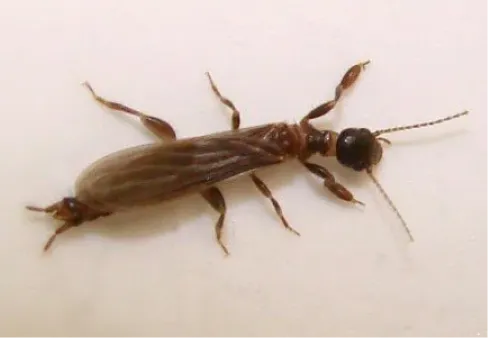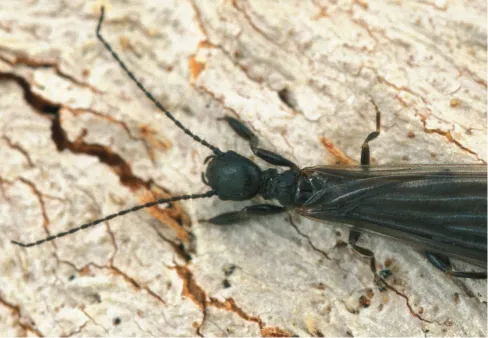Web spinners are small silk-producing insects that spin tunnel-like webs on bark, rocks, and plants, where they feed on mosses, lichens, grasses, and ornamental plants.

Webspinners, also known by their scientific order Embioptera, are small, fascinating insects that often get mistaken for termites because of their appearance. Unlike termites, they do not damage wood. Instead, they are considered harmless nuisance pests. These insects are named for their unique ability to spin silk from special glands located in their front legs. They use this silk to create protective tunnels and sheets that help them move around safely. Webspinners are found throughout the world, living in warm and sheltered environments. You might find them on the surfaces of trees, under rocks, within leaf litter, or tucked into crevices near homes.
Although they sometimes resemble termites, webspinners belong to a completely different insect group. Termites are part of the order Isoptera, while webspinners belong to Embioptera (also called Embiidina). Web spinners are more slender, measure 15–20 mm, and show coloration ranging from brown to black, or pink to red, while termites typically appear cream-colored or dark brown with pale, equal-length wings.
.webp)
Anatomy of Web Spinners
Web spinners have several unique anatomical traits adapted for life inside their silk tunnels:
- Head
- Antennae
- Body
- Wings
- Legs
- Cerci

How to Identify Web Spinners
Web spinners can sometimes be mistaken for termites, but they have several distinctive features. They are slender insects measuring 15–20 mm, with coloration that varies from brown to black, or pink to red. Males have darker, flexible wings, while females and nymphs are wingless. Unlike termites, which are cream-colored or dark brown with pale, equal-length wings, web spinners build fine silk galleries across bark, rocks, and plants, and they move rapidly backward through their tunnels when disturbed.

Habitat of Web Spinners
Web spinners are most common in tropical and subtropical climates but can be found in warmer areas of the southern United States. They live inside silken galleries that cover tree bark, ornamental plants, rocks, leaf litter, and soil surfaces. These galleries retain humidity, provide protection, and allow safe access to food sources. Colonies are subsocial, typically maintained by a female and her offspring, with males leaving the gallery after mating.

Warning Signs of Web Spinners
Key signs of web spinner activity include:
- Networks of silk tunnels spread across bark, stones, or ornamental plants.
- Small, slender insects retreating rapidly inside galleries.
- Feeding activity on moss, lichens, grasses, ornamental plants, and decaying organic matter.
- Silk sheets and tunnel systems appearing across landscaped yards and gardens.
Warning Signs of Web Spinners
Key signs of web spinner activity include:
- Networks of silk tunnels spread across bark, stones, or ornamental plants.
- Small, slender insects retreating rapidly inside galleries.
- Feeding activity on moss, lichens, grasses, ornamental plants, and decaying organic matter.
- Silk sheets and tunnel systems appearing across landscaped yards and gardens.







Control Methods for Web Spinners
Control measures may be necessary when silk accumulations or feeding affect turf and ornamental plants. Effective strategies include:
- Remove visible silk galleries from bark, rocks, and plant surfaces.
- Clear away leaf litter, bark, and plant debris that provide harborage.
- Monitor grasses and ornamental plants for feeding activity.
Web spinners, or Embioptera, are small silk-producing insects that build protective galleries across bark, rocks, and vegetation using silk glands in their front legs.
Web spinners are most common in tropical and subtropical climates but are also found in parts of Southern California and other warm regions of the United States.
Web spinners feed on mosses, lichens, grasses, ornamental plants, and decaying organic matter, often establishing in yards and landscaped gardens.
Unlike termites, web spinners are slender, 15–20 mm long, with coloration ranging from brown to black, or pink to red. Males have darker, flexible wings, while females and nymphs are wingless. They create silk galleries, not mud tubes.
They do not damage wood like termites but may become a nuisance when their silk tunnels spread across ornamental plants, bark, or garden areas.
We Provide the Care toEliminate Termites and Pests For Good
Protecting your home from pests shouldn't be complicated. The Termite Guy makes it simple with wholistic solutions to inspect, treat, and restore your home back to perfection. With a 5 year pest-free warranty and over 25 years of success, we ensure every home is safe and secure.

Inspections

Treatments

Damage Repair
.avif)
.avif)
.avif)
.avif)











































